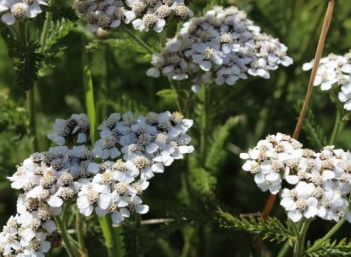Yarrow

Botanical Name: Achillea borealis
Common Name: Northern Yarrow
Other Names: Qanganaruaq (one that never dies)
Found in: Dry to moist, well-drained, open sites, meadows, rocky slopes from coastal to alpine elevations. Thrives in poor soil.
Physical Characteristics: A very common weedy and sturdy perennial, this plant grows up to 24 inches tall. It has fine, ferny, 2-3 times pinnately dissected leaves that are variable in length and width. The leaves are reduced in size as they move up the stem. They have a flat topped cluster of small white flowers (Pratt 1991)
Nutritional Value: The volatile oil contains cineol, a tannin, achilleine, achilletin,k ivain, aconitic acid, stachydrin, choline, and glycocollbetaine. B-sitosterol and achillin, a lactone has also been isolated from this species.
Parts of the plant used: leaves, flowers and roots
When plant should be gathered: Spring, summer and fall
Plant applications: infusion/decoction, plaster, poultice, tincture
Reported Benefits: Infections, sore throats, flu, fever, stomach cramps, mouth sores, kidney and bladder infections, measles, cancer, reduce blood flow, rashes, cuts, itchy areas and boils
Preparation/Processing: This is a common herb of the area; it is used as a remedy for infections and a variety of other ailments. People boil or steep the leaves and the flowers. Some people avoid the flowers because they believe them to be poisonous while others say that they are the strongest medicinal part of the plant.
Yarrow tea is drunk for colds, sore throats, flu, stomach cramps, mouth sores and kidney and bladder infections. People have drunk tea for more serious ailments such as measles and cancer and give accounts of how the medicine helped to cure them. Both before and after a woman delivers a baby, she should drink yarrow tea steadily to cleanse her system and prevent infection.
People use yarrow wash or poultice for a variety of external ailments including rashes, cuts, itchy areas, boils and blisters. They wash the cut with water that yarrow was boiled in. and they use the plant where they have a big infection.
New born children’s umbilical cord is washed with yarrow and or a poultice of the plant may be applied a packing if the cord becomes infected.
Prince William Sound people pulverized the root and put it on boils to heal them.
WARNING: There are some adverse interactions: Always talk to your doctor before taking any new supplement. According to the University of Maryland, yarrow can increase the amount of lithium in the body, which can lead to kidney damage. It also may interact with sedatives, medications that reduce stomach acid, and blood pressure medications. Pregnant and breastfeeding women should not take yarrow.
